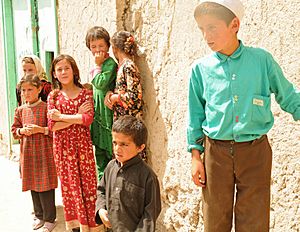Tajik people facts for kids

Tajik children from Badakhshan Province of Afghanistan
|
|
| Total population | |
|---|---|
| c. 18–27 million | |
| Regions with significant populations | |
| 9,450,000–11,550,000 (2014) 27–33% |
|
| 6,787,000 (2014) | |
| 1,420,000 (2012, official) other, non-official, scholarly estimates are 8 – 11 million |
|
| 39,642 | |
| 201,000 | |
| 52,000 | |
| 47,500 | |
| 15,870 | |
| 4,255 | |
| unknown | |
| Languages | |
| Persian (varieties of Dari and Tajiki) |
|
| Religion | |
| Sunni Islam Shia Islam minorities |
|
The Tajiks are a group of people who speak a language called Persian. They are mostly found in Tajikistan, but also live in parts of Afghanistan, Uzbekistan, and China. Sometimes, Tajiks are also called Eastern Persian, Dehqan, or Farsiwan.
After the Soviet invasion of Afghanistan in 1979, some Tajiks moved to nearby Iran and Pakistan. Most Tajiks follow the Sunni branch of Islam. However, a few in mountain areas and cities like Herat and Kabul follow Shia Islam.
Contents
Who Are the Tajiks?
The name Tajik started being used for this group of people in the early 1900s by the Russians. Before that, they were sometimes called Sarts. The name Tajik describes people who have traditionally lived in one place (not moving around) and speak a form of Persian. This language is called Tajiki in Tajikistan and Uzbekistan, and Dari in Afghanistan.
What Does the Name 'Tajik' Mean?
Many people believe the word Tajik comes from an old Persian word, Tāzīk, which meant "Arab". Some Turks in Central Asia used a similar word, Täžik, to describe the Persian-speaking Muslims. These Persian Muslims lived near the Oxus River and in a region called Khorasan. They were often rivals of the Turks.
Where Do Tajiks Come From?
Historians think that Tajiks might be connected to ancient people called Aryans. These Aryans lived in the region thousands of years ago. They helped spread the culture of people who settled down in Central Asia. This culture spread from the Iranian plateau to an area from the Caspian Sea to China.
The Aryans were a main part of the old populations in places like Khwarezm, Sogdiana, and Bactria. These areas were part of a larger region called Transoxania. Over time, they mixed with other groups who came to the area, such as the Mauryans, Kushans, and Hepthalites.
The language these ancient people spoke slowly changed into Farsi. This is a western dialect now spoken officially in Iran, Afghanistan, and Tajikistan.
Tajiks and Other Groups
In the 13th century, Genghis Khan and his Mongol army came to many Persian cities. Later, these Mongols adopted the Persian language and the religion of Islam. Some Persian-speaking people today, like the Hazaras, say they are partly descended from these Mongols.
However, Tajiks usually say they are not from Mongol or Turkic groups. They believe they are descendants of the ancient Iranians of Central Asia. Historically, there has been a lot of mixing between Turkic-speaking and Persian-speaking people in Central Asia.
Related pages
- From the Alleyways of Samarkand to the Mediterranean Coast (The Evolution of the World of Child and Adolescent Literature,Tajikistan, Poopak Niktalab , printed 2019 , Faradid Publishing
- TAJIK i. THE ETHNONYM: ORIGINS AND APPLICATION, Encyclopædia Iranica, Last Updated: July 20, 2009, www.iranica.com
Images for kids
-
The Samanid Empire (819–999) is considered the first Tajik state
-
Tajiks Celebrate Nawrooz in Afghanistan. Haft-Seen, White House ceremony for new Persian Year, prepared by Laura Bush.
-
Burhanuddin Rabbani served as President of Afghanistan
-
View of the Registan in Samarkand – although the second largest city of Uzbekistan, it is predominantly a Tajik populated city, along with Bukhara.
-
Balkh Governor Atta Muhammad Nur after visiting the Blue Mosque in Mazar-i-Sharif's in northern Afghanistan.
-
Emomalii Rahmon with then Russian President Dmitry Medvedev in 2009
See also
 In Spanish: Tayikos para niños
In Spanish: Tayikos para niños








